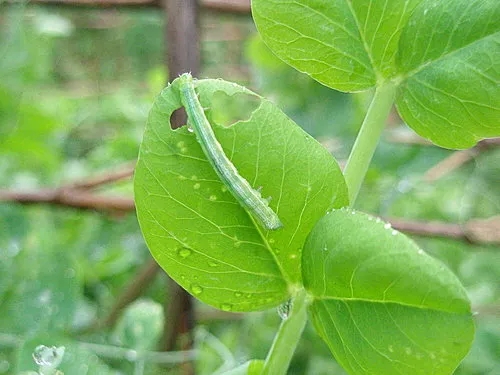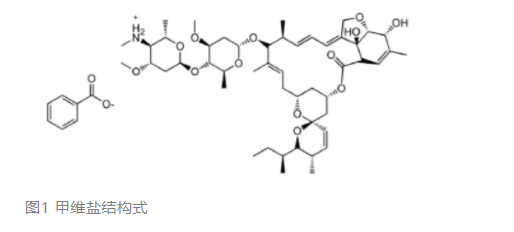Research progress on the resistance mechanism of emamectin benzoate emamectin benzoate (emamectin benzoate, referred to as emamectin salt, the structural formula is shown in Figure 1, it was a product of Merck in the United States in 1984 The results of the company’s derivatization research on the hydroxyl group on 4″-(α-1-oleanosyl)-α-1-oleanose. As a new type of antibiotic biogenic pesticide, emamectin salt has a wide range of It has the advantages of spectrum, high efficiency, low toxicity, low residue, etc., and has good insecticidal effect on lepidopteran pests. The LC90 value of emamectin salt on some lepidopteran insects ranges from 0.002 to 0.89 mg/L. With its lead compound Avitamin Compared with abamectin, emamectin salt is less toxic and its toxicity to rats is only 1/6 of abamectin. It is safe for humans and livestock at regular doses and is easy to degrade.
In the past few decades, due to the unique mode of action of the new insecticide emamectin and its good toxicity to lepidopteran pest larvae, such as diamondback moth, rapae caterpillar and other important vegetable pests, It has special effects on diamondback moth and beet armyworm, and has high activity against mite pests. It was introduced in my country to control the damage of lepidopteran pests. It was initially used to control diamondback moth on vegetables such as cabbage, cabbage and radish, and then gradually Extended to cash crops and even field crops. Its control effect against many pests is unmatched by other pesticides: its relative toxicity to diamondback moth, exigua exigua, stem borer and spider mite are 10.54, 10.50, 1.50 and 0.69 of abamectin respectively. , its toxicity to subtropical armyworms is 1720, 884, and 268 times higher than methomyl, thiodicarb, and fenvalerate, and its insecticidal activity against lepidopteran pests is 1500 times higher than that of abamectin, such as beet The gastric toxicity of Spodoptera exigua, Spodoptera exigua and Spodoptera exigua is 1166, 43 and 105 times that of abamectin respectively.

Although the development of lepidopteran pest resistance to avermectin insecticides in my country has not yet caused obvious field control failures, and large-scale outbreaks of avermectin insecticide resistance have not yet occurred, but In recent years, research and field resistance monitoring have found that some vegetable pests have developed resistance to them, and the resistance is gradually increasing. Therefore, we must attach great importance to this potential risk to prevent failure of control from causing large-scale crop yield reduction or even failure. In order to delay the emergence and development of pest resistance to emamectin salt and extend its service life, it is necessary to conduct in-depth research on its mechanism of action, resistance status and resistance mechanism.

1. Overview of research on the development of resistance to emamectin salt
Currently, emamectin salt/abamectin is commonly used to control vegetable pests, such as diamondback moth, exigua exigua, Spodoptera litura, etc. Due to its good control effect, it has been widely used in the control of cruciferous vegetable pests and It effectively controls the scale of lepidopteran pest populations and slows down the evolution of resistance to traditional pesticides. However, the adaptive evolution of resistance of lepidopteran pests to sixteen-membered macrolide pesticides such as emamectin salts has posed a major challenge to the sustainable control of lepidopteran pests by these pesticides. There are reports on insecticide resistance confirming that the resistance of diamondback moth to this type of insecticide is becoming increasingly serious. Yin Yong conducted resistance monitoring work on field populations of Spodoptera exigua in some areas and found that Spodoptera exigua populations in some areas have developed low to moderate levels of resistance to emamectin. Si Shengyun et al. reported that the resistance of Spodoptera exigua field populations in Yichang to emamectin has reached a moderate resistance level. Che et al. also reported that some field populations of Spodoptera exigua are highly resistant to emamectin (Shanghai, Yunnan and other places).
2. Overview of research on the resistance mechanism of emamectin salt
Existing studies believe that the resistance of arthropods and nematodes to macrolides, such as abamectin and emamectin, is in most cases related to multiple genetic factors. Main mechanisms include: metabolic resistance, including cytochrome P450 monooxygenase (P450), glutathione S-transferase (GST), and esterase (EST) in detoxifying metabolic enzymes; reduced cuticle penetration of pesticides ; Target site insensitivity, such as conformational changes in gated chloride channels; During the detoxification process of phase III, the adenosine triphosphate nodule box transporter (abbreviated as ABC transporter, ATP-bindingcassette transporter, ABC-transporter) on the cell membrane, the ABC transporter It can actively pump toxic substances out of cells, helping insects resist xenobiotics.
2.1 Detoxification metabolic enzyme resistance
Researchers believe that the mechanism of action of emamectin salt is similar or identical to its analogue abamectin, and can also be caused by changes in the activity of multifunctional oxidases. Guo Wei confirmed the detoxification and metabolic effects of the rice leaf roller’s detoxification and metabolism enzymes on emamectin salt through synergist experiments, indicating that changes in the activity of detoxification and metabolism enzymes may lead to the formation of rice leaf roller resistance to emamectin salt. It has been reported that the resistance to abamectin in diamondback moth is related to multifunctional oxidase through synergist experiments, and the same results have also been found in potato beetles. Other studies have found that changes in the activity of the three major detoxification metabolic enzymes are the main reason why Western flower thrips are resistant to emamectin salt.
2.2 Target resistance
Zhao Weidong et al. reported that changes in acetylcholinesterase activity are one of the important reasons for the resistance of two-spotted spider mites to abamectin. The same results have also been verified in the abamectin-resistant population of western flower thrips. �Current studies have shown that avermectin/emamectin is a substrate of P-gp and can induce an increase in the expression of ABC transporter. The increase in P-gp mRNA expression may lead to a decrease in the effectiveness of avermectin drugs.
Conclusion
To sum up, the resistance mechanism of insects to emamectin salts is complex, and the resistance mechanisms of different insect populations are also different. Therefore, studying the resistance mechanism of insects to emamectin salts can provide scientific and rational use of this class. Pesticides provide important scientific basis for extending product life. Emamectin salts can be mixed or used in rotation with a variety of other insecticides with different mechanisms of action to delay the development and development of insect resistance to them. In some areas with high levels of resistance to avermectins, the use of such agents should be stopped or suspended immediately, and the use plan should be re-planned until the level of resistance to avermectins in the area decreases to prevent field pests from becoming resistant. The frequency of sexual genes increases and the controllability of this type of pesticide against pests is lost.


